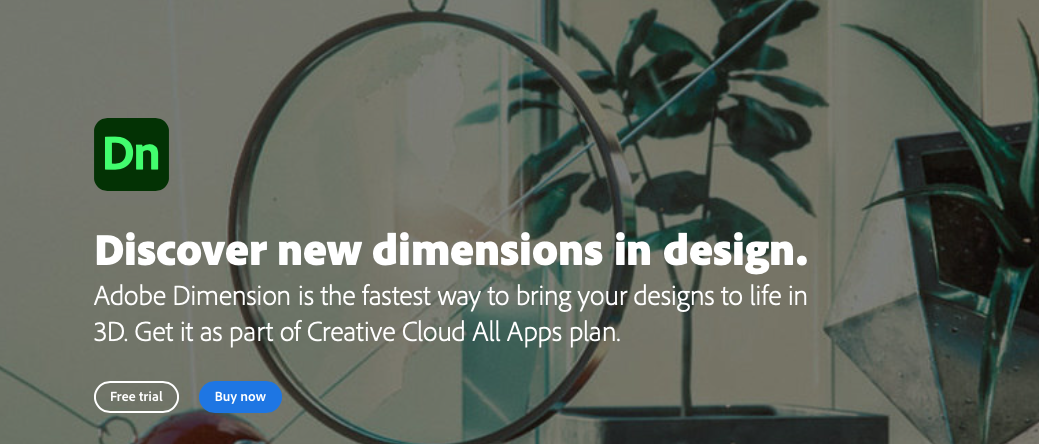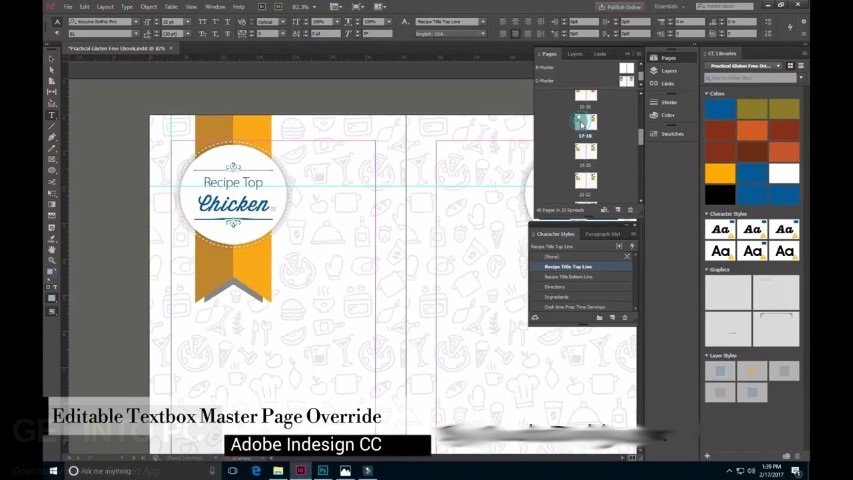Whether it’s a simple cereal box or a stylized wine bottle, bring your product prototype to life by composing, adjusting, and rendering 3D photorealistic images with Dimension. Work quickly and efficiently. Stop wasting time approximating 3D images in other design software by easily creating box and food packaging mockups in just a few steps. Adobe does offer a collection of free mobile apps for both iOS and Android. Learn more › Can I get Dimension without a Creative Cloud membership? No, Dimension is available only as part of a Creative Cloud membership. You can choose a Single App plan with Dimension only or a plan that includes more apps. Adobe Dimension Feedback Portal. Thank you for taking the time to share your ideas about Dimension! We will use your insights to guide our product roadmap.
| Developer(s) | Adobe Systems |
|---|---|
| Initial release | October 18, 2017; 3 years ago |
| Stable release | CC 2020 / September 30, 2020; 6 months ago |
| Written in | C++ |
| Operating system | Windows and macOS |
| Available in | 26 languages |
English (United States), English (United Kingdom), Arabic, Chinese Simplified, Chinese Traditional, Czech, Danish, Dutch, Finnish, French, German, Hebrew, Hungarian, Italian, Japanese, Korean, Norwegian, Polish, Portuguese, Russian, Spanish, Swedish, Romanian, Turkish and Ukrainian | |
| Type | Raster graphics editor |
| License | Trialware, SaaS |
| Website | www.adobe.com/products/dimension.html |
Adobe Dimension (formerly Project Felix) is a 3D rendering and designsoftware developed and published by Adobe Systems for macOS and Windows.[1]
It started out as Project Felix on March 28, 2017, and became Dimension on October 18, 2017. Unlike other modeling programs such as SketchUp, models are not created in Dimension. Instead, it is a photo-based mockup editor where models, photos and textures need to be created in third party software before being imported into Dimension. Once in Dimension, models and images can be composed into arrangements before being rendered to 2D photo realistic images.
Originally relying on the V-Ray rendering engine, in April 2019 Adobe switched to its own 3D rendering engine called Adobe Rendering Engine (ARE) with the release of Dimension CC2.2, and stated that support for external rendering engines may be considered in the future.[2]
Contrary to popular belief, Adobe had a similar program called Adobe Dimensions back in 1993, which specialized in 3D-dimensional artwork. It only lasted a few years of support and had garnered lower sales compared to Illustrator/Photoshop, and it was discontinued quickly.
References[edit]
- ^Lardinois, Frederic (October 18, 2017). 'Adobe launches Dimension CC, its 3D compositing tool formerly known as Project Felix'. TechCrunch. Retrieved May 9, 2018.
- ^'Adobe ships Dimension CC 2.2'. CG Channel.
Adobe Dimension digitally transforms the traditional photography studio, helping you bring concepts to life in prototype form, combining 3D models and 2D images with dynamic lighting and photorealistic rendering. With its ability to reduce the time it takes to iterate and make better design decisions, Dimension empowers you to digitally showcase consumer-packaged goods and product mockups like no other tool.
Adobe Dimension
Discover new dimensions in design.
Dimension’s latest release, version 3.4, focuses on more creative control for product designs. New to Dimension, the UV Export feature gives you the ability to place graphics on a specific part of a 3D model. Multidisciplinary designer and educator Julia Masalska is a big fan of the feature, and in this article we’ll follow along with her as she uses UV export along with Photoshop and Illustrator for a brand exploration project. Masalska named the brand she created “easy” and designed their sunscreen product shots, which naturally makes you want to grab the product on a hot, sunny afternoon!
Staged and rendered using Dimension.
Using materials for fast photorealism
Dimension has a wide range of features for controlling the appearance of your models, and Masalska used many of these in her project. She started with selecting her materials. She had to decide what her objects were made of, like shiny plastic or textured stones, which is a crucial step in setting up the right look on her products, not unlike the real world.
| Pull Quote |
|---|
“I’m making sure materials work with the environment where the product would naturally live. A more elegant product may live on a surface that’s marble or more high- end materials.”Julia Masalska |
| Animation |
|---|
| https://hlx.blob.core.windows.net/external/ae9fa00dc93cc91709943db4ca56a67b66a32bbe#image.mp4 |
Applying Substance materials.
Dimension supports Substance by Adobe materials, which are handcrafted in Substance Designer and published in a parametric format, making it easy for artists to customize. Substance materials let artists like Masalska easily control the look of their material while the app does the hard work of creating textures and configuring the material channels.

Precise textures with the UV Export feature
Placing graphics in Dimension is a light and simple workflow. Just drag and drop a graphic onto the 3D model and it will be placed as a graphic layer. This is a quick workflow that lets the user control the graphic position, rotation, and scale directly on the surface. You can switch to fill mode for wrapping and repeating patterns, and decal mode for placing stickers and isolated elements. Gulbransen piano serial number lookup.
| Pull Quote |
|---|
“… But I don’t think I’ll go back from UV Export! It makes it so much better to align my design so perfectly and create a layout.”Julia Masalska |
There may be cases where you need more precise placement of your decals, and that is where UV Export comes in. UVs are a representation of a 3D model flattened into 2D space with coordinates that precisely map back to the corresponding points on the 3D surface. Like in print, where a die line can be folded into a 3D object, UVs are the complete opposite; a UV model is a 3D object, flattened to 2D! UVs provide you with the template to create textures for models in your chosen image editing application.
| Pull Quote |
|---|
“I found my workflow really adapted easily to UV Export. Because I noticed how much value it actually brings to the workflow. You can use guides, you can play around with the layout, knowing where the frame is, where the borders are.”Julia Masalska |

Masalska is using the UV Export feature to apply her graphics so she can get the exact look on the 3D model later.
Masalska exported a UV for the tube model in order to better design for the edge of the cap on the tube. She gets a PSD file with helper layers to identify the parts on the flattened version of her object. Using the UV guide layers that are automatically generated by Dimension, she identified which area she wanted to paint her texture on and used linked graphics to edit seamlessly with Photoshop. This also helped her design for multiple different SKUs, all in one texture file.
| Animation |
|---|
| https://hlx.blob.core.windows.net/external/a959379ca25bf90137d873255cbef368531aeaa7#image.mp4 |
Work seamlessly across apps: center using Photoshop.
| Pull Quote |
|---|
“… It’s very helpful to see the model overlay, to see the complexion of the model, the folds and curves that are part of the design and need to be considered in the process. That helps me not design in 2D and bring it to 3D, but to right away start designing in 3D.”Julia Masalska |
Staged and rendered using Dimension.
Masalska took advantage of the connected Adobe ecosystem via Creative Cloud Libraries. She worked seamlessly while designing across applications — creating logos in Illustrator and accessing them directly in Photoshop to place on the UV Export file. As she updates her designs in Photoshop, the changes are picked up in Dimension, and she is able to see the final results instantly!
| Pull Quote |
|---|
“… I create the typefaces, iconography, and colors in Illustrator. Then I created a Library to sum all these up and used the Creative Cloud Library in Photoshop to place it onto the UV Export File.”Julia Masalska |
Extend Dimension with Substance Apps
As we’ve seen by following along with Masalska, Dimension is a powerful tool that enables quick visualization and rendering, the digitization of graphic design, and prototyping. This power is extended by the Substance suite of tools. Substance Painter and Substance Alchemist empower designers to create using professional texturing workflows, fully supported for import to Dimension, bringing more capability into your hands.
Use Substance Source and Adobe Stock to access more material and model content, made and optimized for Adobe Dimension.
Download Dimension’s latest release today. Learn more about UV Export on HelpX.
Julia Masalska.
Fallout 3 dlc pc download. To learn more about Julia Masalska and see more of her incredible work, head over to her YouTubechannel.
Adobe Dimension
Julia Masalska is a multidisciplinary designer and educator. While her freelance work mostly focuses around branding and packaging, she is inspired by the world of experiment across Adobe software. Working as an educator to a worldwide audience, she is interested in sharing her knowledge and expertise with freelance designers. Julia is known for her improvisation skills creating stunning designs in a short period of time, as well as her work as a design host on Adobe Live and on her own YouTube channel.
